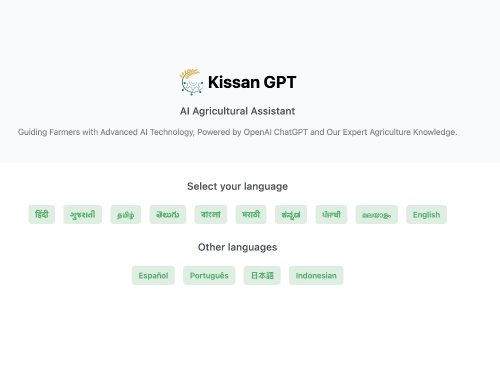
India’s agriculture sector is the backbone of the country’s economy, providing livelihoods to millions of people. However, with the increasing population and growing demand for food, there is a need for agricultural practices that are efficient and sustainable. Kissan GPT is an innovative technology solution designed to help farmers in India improve their yields and increase profitability. In this blog post, we delve into the case study of Kissan GPT and explore how it has transformed the lives of Indian farmers by revolutionizing traditional farming practices.
Kissan GPT
Kissan GPT is an advanced multilingual chatbot that utilizes Open AI technology. It was created to provide farmers with personalized, voice-enabled assistance for all their agricultural needs. The AI chatbot, which is suitable for farmers and others interested in agriculture, has numerous potential benefits.
Features
- Personalized Support: Kissan GPT offers customized and individualized assistance to farmers based on their specific needs and inquiries. By utilizing OpenAI’s ChatGPT technology, it can generate natural language responses to farmers’ questions and provide them with the information they require to make informed decisions about their agricultural practices.
- Voice-Enabled: Unlike ChatGPT, Kissan GPT provides support through voice-enabled communication, including regional languages. This can be particularly helpful for farmers who have limited literacy or language proficiency. Voice-enabled support also enables farmers to access information without the need for manual input, making it easier for them to perform tasks while receiving assistance.
- Multilingual Assistance: Kissan GPT supports multiple languages, which can be beneficial for farmers who speak different dialects. By providing assistance in multiple languages, it can help farmers overcome language barriers and access information in other languages.
How does Kissan GPT Works?
Kissan GPT utilizes OpenAI’s state-of-the-art ChatGPT technology in combination with its own knowledge repository. While building on top of ChatGPT, which is a text-based AI system, Kissan GPT goes beyond that by offering voice-based responses.
Kissan GPT converts ChatGPT’s written text into spoken output using Text-To-Speech (TTS) technology. TTS technology employs synthetic voices to translate written text into spoken words, which are then delivered to the user through a speaker or headset. It leverages a TTS engine to transform ChatGPT’s natural language text into speech output. TTS engines generate lifelike synthetic voices from a library of human speech sounds and phonemes. In essence, Kissan GPT utilizes these two technologies to provide multilingual support.
It’s heartening to see that artificial intelligence is being employed to assist agriculture and the farming community, both of which are critical in ensuring that people worldwide have access to food.
Our take on Kissan GPT
This application is an incredibly helpful tool for farmers, with no doubt about it. What impresses me the most about this application are its multilingual support and voice input/output capabilities. It has the potential to break down language barriers, which is a significant benefit for many people, especially farmers in rural India. With the help of AI, farmers can ask questions and receive detailed outputs. Furthermore, the application generates both text and voice outputs simultaneously, which is an added advantage.
Regarding cons, one thing that concerns me about this application is that responses are sometimes directed to the earpiece instead of the speakers, rendering the voice inaudible. Additionally, the responses take longer than Chat GPT since the TTS system is involved. I believe that the communication between the Chat GPT API, data collection, and TTS conversion into regional languages is the likely cause of this delay.
As the application is still in its early stages, I am optimistic that these flaws will be addressed in future versions. Overall, Kissan GPT has the potential to provide valuable support to farmers and anyone interested in agriculture. By leveraging AI technology, it can overcome language barriers and provide personalized, voice-based assistance.

















